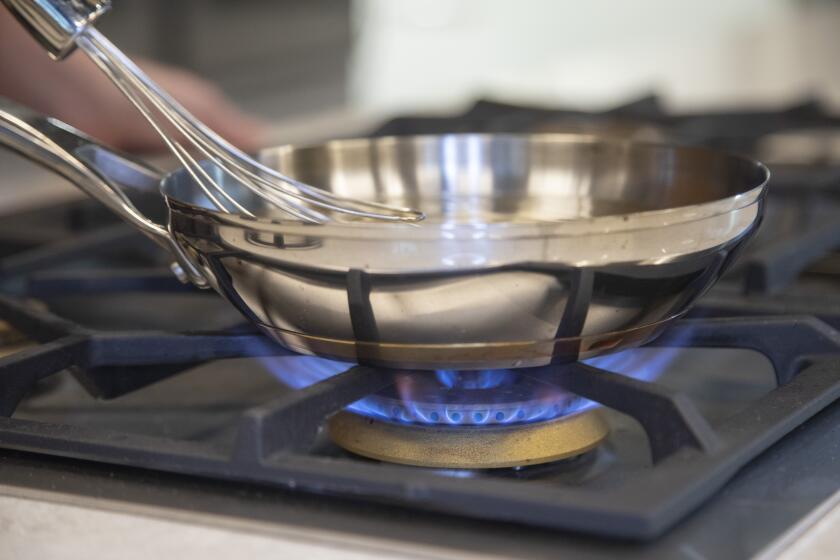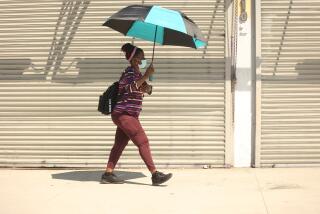Editorial: It’s getting hotter in L.A. A/C is no longer a luxury, but a safety requirement

- Share via
As California emerges from the second heat wave just this month, it is worth noting that millions of residents are living without air conditioning.
Nearly one-quarter of California households lack air conditioning, according to 2019 federal data, and in rental units, there is no requirement that landlords protect tenants from dangerously hot temperatures inside their homes and apartments.
While state law requires residential units to have heating systems to keep indoor temperatures above 70 degrees during cold weather, there is nothing requiring air conditioning or other cooling measures to keep residents safe from extreme heat. It’s a grave injustice that there is no upper temperature limit for housing, even as climate change is making temperatures rise, threatening the health and lives of Californians.
The L.A. Times’ editorial board endorsements for statewide ballot measures, elected offices in Los Angeles city and county, L.A. Unified School District board, L.A. county superior court, statewide offices, the state Legislature and U.S. House and Senate seats.
State lawmakers could have fixed that this year, by passing a bill that would have required state regulators to establish statewide safe-temperature standards and cooling requirements for residential units. But the bill died and the Legislature instead directed the state Department of Housing and Community Development to report back by 2025 with recommendations for establishing a maximum safe indoor temperature.
That’s too long to wait, which is why we are glad that local leaders are stepping up. Earlier this month, Los Angeles City Council President Nury Martinez presented a motion directing city officials to come up with ways to update city code to “require sufficient cooling apparatuses in residential rental units.” The motion must still go through required committee hearings before the council votes on it, but it’s a good first step.
Climate change has already made air-conditioning a necessity in many neighborhoods where it used to be uncommon, and requirements for indoor temperatures should be enshrined in law. State and local leaders need to start treating cooling as essential to health and safety as heating or smoke detectors, and required for housing to be considered habitable.
California is experiencing the most dangerous heat wave of the year, but efforts by state lawmakers to protect residents from these climate-fueled disasters seem to have largely fizzled out.
The City Council should move ahead swiftly to adopt cooling standards for rental units, which could save lives and reduce the unequal distribution of cooling infrastructure that inflicts harm disproportionately on poor people and communities of color.
Martinez’s motion appropriately focuses on tenants who are largely at the mercy of landlords, who may not provide air-conditioning units or even allow tenants to use their own. A home should be a place of refuge, but that’s often not the case in older housing that tends to be poorly insulated and lack air conditioning. During heat waves, temperatures can climb higher inside than outside, creating a dangerous environment that puts residents at increased risk of illness and death from a variety of causes, including heart attacks, strokes and respiratory or kidney failure.
Some cities, such as Dallas and Tempe, Ariz., already require air conditioning or other cooling equipment in rental units, and generally require property owners to keep indoor temperatures below certain levels.
Don’t fear L.A’s gas appliance ban. The future is electric.
Lobbying associations for apartment owners and other interest groups representing landlords opposed the state measure and are likely to object to a local cooling standard because of the cost of new equipment.
That’s a reasonable concern and city officials should craft this in a way that does not overly burden property owners or tenants and offers financial assistance for the installation of cooling appliances and to help low-income households pay their energy bills. An air conditioner is useless during a heat wave if you can’t afford to run it. Cooling upgrades should be paired wherever possible with energy efficiency improvements, like solar reflective roofs and insulation, to minimize greenhouse gas emissions and strain on the electrical grid.
The proposal to develop cooling standards comes at a fortuitous time. The city is phasing out natural gas appliances from new buildings to reduce climate emissions, and the state has earmarked nearly $1 billion in funding for energy efficiency upgrades in low-income households. The effort also dovetails with President Biden’s recent signing of the Inflation Reduction Act, which, among other things, will provide extensive credits, rebates and other incentives for the installation of insulation and electric cooling appliances.
Heat is the nation’s deadliest climate hazard. California chronically undercounts its toll and has failed to adequately address it. We can think of few priorities more worthwhile than protecting people from preventable illness and death inside their homes.
More to Read
A cure for the common opinion
Get thought-provoking perspectives with our weekly newsletter.
You may occasionally receive promotional content from the Los Angeles Times.













